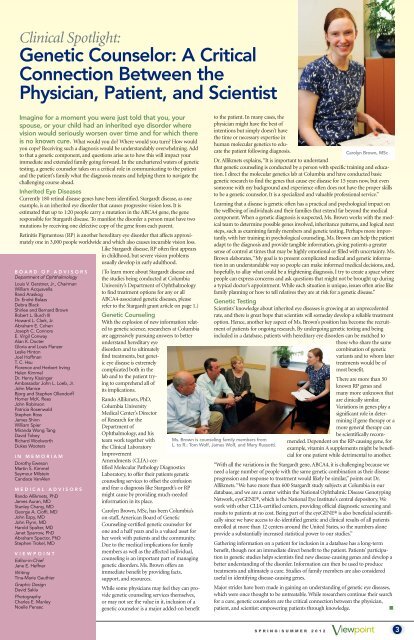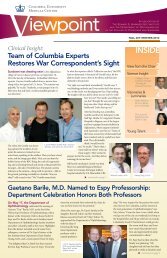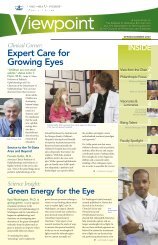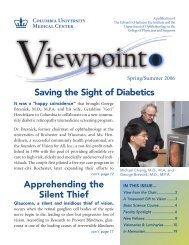continued from page 1 - Edward Harkness Eye Institute
continued from page 1 - Edward Harkness Eye Institute
continued from page 1 - Edward Harkness Eye Institute
Create successful ePaper yourself
Turn your PDF publications into a flip-book with our unique Google optimized e-Paper software.
Clinical Spotlight:<br />
Genetic Counselor: A Critical<br />
Connection Between the<br />
Physician, Patient, and Scientist<br />
Imagine for a moment you were just told that you, your<br />
spouse, or your child had an inherited eye disorder where<br />
vision would seriously worsen over time and for which there<br />
is no known cure. What would you do? Where would you turn? How would<br />
you cope? Receiving such a diagnosis would be understandably overwhelming. Add<br />
to that a genetic component, and questions arise as to how this will impact your<br />
immediate and extended family going forward. In the unchartered waters of genetic<br />
testing, a genetic counselor takes on a critical role in communicating to the patient<br />
and the patient’s family what the diagnosis means and helping them to navigate the<br />
challenging course ahead.<br />
Inherited <strong>Eye</strong> Diseases<br />
Currently 180 retinal disease genes have been identified. Stargardt disease, as one<br />
example, is an inherited eye disorder that causes progressive vision loss. It is<br />
estimated that up to 1:20 people carry a mutation in the ABCA4 gene, the gene<br />
responsible for Stargardt disease. To manifest the disorder a person must have two<br />
mutations by receiving one defective copy of the gene <strong>from</strong> each parent.<br />
Retinitis Pigmentosa (RP) is another hereditary eye disorder that affects approximately<br />
one in 3,000 people worldwide and which also causes incurable vision loss.<br />
Like Stargardt disease, RP often first appears<br />
in childhood, but severe vision problems<br />
usually develop in early adulthood.<br />
BOARD OF ADVISORS<br />
Department of Ophthalmology<br />
Louis V. Gerstner, Jr., Chairman<br />
William Acquavella<br />
Rand Araskog<br />
Dr. Endré Balazs<br />
Debra Black<br />
Shirlee and Bernard Brown<br />
Robert L. Burch III<br />
Howard L. Clark, Jr.<br />
Abraham E. Cohen<br />
Joseph C. Connors<br />
E. Virgil Conway<br />
Alan K. Docter<br />
Gloria and Louis Flanzer<br />
Leslie Hinton<br />
Joel Hoffman<br />
T. C. Hsu<br />
Florence and Herbert Irving<br />
Helen Kimmel<br />
Dr. Henry Kissinger<br />
Ambassador John L. Loeb, Jr.<br />
John Manice<br />
Bjorg and Stephen Ollendorff<br />
Homer McK. Rees<br />
John Robinson<br />
Patricia Rosenwald<br />
Stephen Ross<br />
James Shinn<br />
William Spier<br />
Miranda Wong Tang<br />
David Tobey<br />
Richard Woolworth<br />
Dukes Wooters<br />
IN MEMORIAM<br />
Dorothy Eweson<br />
Martin S. Kimmel<br />
Seymour Milstein<br />
Candace VanAlen<br />
MEDICAL ADVISORS<br />
Rando Allikmets, PhD<br />
James Auran, MD<br />
Stanley Chang, MD<br />
George A. Cioffi, MD<br />
John Espy, MD<br />
John Flynn, MD<br />
Harold Spalter, MD<br />
Janet Sparrow, PhD<br />
Abraham Spector, PhD<br />
Stephen Trokel, MD<br />
VIEWPOINT<br />
Editor-in-Chief<br />
Jane E. Heffner<br />
Writing<br />
Tina-Marie Gauthier<br />
Graphic Design<br />
David Sakla<br />
Photography<br />
Charles E. Manley<br />
Noelle Pensec<br />
(To learn more about Stargardt disease and<br />
the studies being conducted at Columbia<br />
University’s Department of Ophthalmology<br />
to find treatment options for any or all<br />
ABCA4-associated genetic diseases, please<br />
refer to the Stargardt grant article on <strong>page</strong> 1.)<br />
Genetic Counseling<br />
With the explosion of new information related<br />
to genetic science, researchers at Columbia<br />
are aggressively pursuing answers to better<br />
understand hereditary eye<br />
disorders and to ultimately<br />
find treatments, but genetic<br />
eye disease is extremely<br />
complicated both in the<br />
lab and to the patient trying<br />
to comprehend all of<br />
its implications.<br />
Rando Allikmets, PhD,<br />
Columbia University<br />
Medical Center’s Director<br />
of Research for the<br />
Department of<br />
Ophthalmology, and his<br />
team work together with<br />
the Clinical Laboratory<br />
Improvement<br />
Amendments (CLIA)-certified<br />
Molecular Pathology Diagnostics<br />
Laboratory, to offer their patients genetic<br />
counseling services to offset the confusion<br />
and fear a diagnosis like Stargardt’s or RP<br />
might cause by providing much-needed<br />
information in its place.<br />
Carolyn Brown, MSc, has been Columbia’s<br />
on-staff, American Board of Genetic<br />
Counseling-certified genetic counselor for<br />
one and a half years and is a valued asset for<br />
her work with patients and the community.<br />
Due to the medical implications for family<br />
members as well as the affected individual,<br />
counseling is an important part of managing<br />
genetic disorders. Ms. Brown offers an<br />
immediate benefit by providing facts,<br />
support, and resources.<br />
While some physicians may feel they can provide<br />
genetic counseling services themselves,<br />
or may not see the value in it, inclusion of a<br />
genetic counselor is a major added-on benefit<br />
to the patient. In many cases, the<br />
physician might have the best of<br />
intentions but simply doesn’t have<br />
the time or necessary expertise in<br />
human molecular genetics to educate<br />
the patient following diagnosis.<br />
Carolyn Brown, MSc<br />
Dr. Allikmets explains, “It is important to understand<br />
that genetic counseling is conducted by a person with specific training and education.<br />
I direct the molecular genetics lab at Columbia and have conducted basic<br />
genetic research to find the genes that cause eye disease for 15 years now, but even<br />
someone with my background and experience often does not have the proper skills<br />
to be a genetic counselor. It is a specialized and valuable professional service.”<br />
Learning that a disease is genetic often has a practical and psychological impact on<br />
the wellbeing of individuals and their families that extend far beyond the medical<br />
component. When a genetic diagnosis is suspected, Ms. Brown works with the medical<br />
team to determine possible genes involved, inheritance patterns, and logical next<br />
steps, such as examining family members and genetic testing. Perhaps more importantly,<br />
with her training in psychological counseling, Ms. Brown can help the patient<br />
adapt to the diagnosis and provide tangible information, giving patients a greater<br />
sense of control at times that may be highly emotional or filled with uncertainty. Ms.<br />
Brown elaborates, “My goal is to present complicated medical and genetic information<br />
in an understandable way so people can make informed medical decisions, and,<br />
hopefully, to allay what could be a frightening diagnosis. I try to create a space where<br />
people can express concerns and ask questions that might not be brought up during<br />
a typical doctor’s appointment. While each situation is unique, issues often arise like<br />
family planning or how to tell relatives they are at risk for a genetic disease.”<br />
Genetic Testing<br />
Scientists’ knowledge about inherited eye diseases is growing at an unprecedented<br />
rate, and there is great hope that scientists will someday develop a reliable treatment<br />
option. Hence, another key aspect of Ms. Brown’s position has become the recruitment<br />
of patients for ongoing research. By undergoing genetic testing and being<br />
included in a database, patients with hereditary eye disorders can be matched to<br />
those who share the same<br />
combination of genetic<br />
variants and to whom later<br />
treatments would be of<br />
most benefit.<br />
Ms. Brown is counseling family members <strong>from</strong><br />
L. to R.: Tom Wolf, James Wolf, and Mary Russotti.<br />
There are more than 50<br />
known RP genes and<br />
many more unknown that<br />
are clinically similar.<br />
Variations in genes play a<br />
significant role in determining<br />
if gene therapy or a<br />
more general therapy can<br />
be scientifically recommended.<br />
Dependent on the RP-causing gene, for<br />
example, vitamin A supplements might be beneficial<br />
for one patient while detrimental to another.<br />
“With all the variations in the Stargardt gene, ABCA4, it is challenging because we<br />
need a large number of people with the same genetic combination as their disease<br />
progression and response to treatment would likely be similar,” points out Dr.<br />
Allikmets. “We have more than 600 Stargardt study subjects at Columbia in our<br />
database, and we are a center within the National Ophthalmic Disease Genotyping<br />
Network, eyeGENE®, which is the National <strong>Eye</strong> <strong>Institute</strong>’s central depository. We<br />
work with other CLIA-certified centers, providing official diagnostic screening and<br />
results to patients at no cost. Being part of the eyeGENE® is also beneficial scientifically<br />
since we have access to de-identified genetic and clinical results of all patients<br />
enrolled at more than 12 centers around the United States, so the numbers alone<br />
provide a substantially increased statistical power to our studies.”<br />
Gathering information on a patient for inclusion in a database has a long-term<br />
benefit, though not an immediate direct benefit to the patient. Patients’ participation<br />
in genetic studies helps scientists find new disease-causing genes and develop a<br />
better understanding of the disorder. Information can then be used to produce<br />
treatments and ultimately a cure. Studies of family members are also considered<br />
useful in identifying disease-causing genes.<br />
Major strides have been made in gaining an understanding of genetic eye diseases,<br />
which were once thought to be untreatable. While researchers continue their search<br />
for a cure, genetic counselors are the critical connection between the physician,<br />
patient, and scientist: empowering patients through knowledge.<br />
SPRING/SUMMER 2012<br />
Vıewpoınt 3





